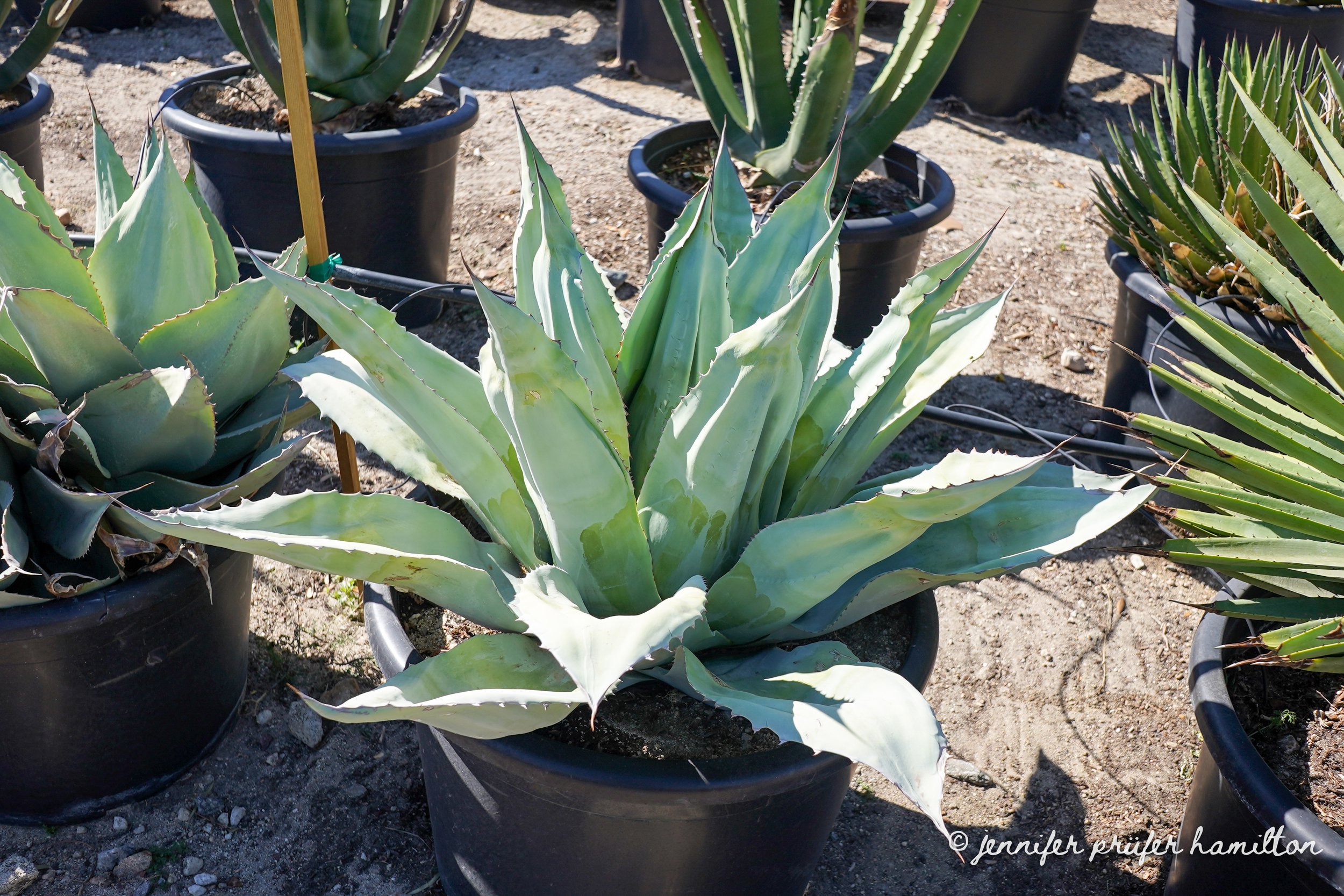Whale's Tongue Agave
Whale’s tongue agave is a striking plant that blends well with other plants in a desert landscape.
It has distinct leaves with a muted gray-green tone. The broad leaves indent vertically in the middle and taper at the end like a tongue.
When it reaches its eventual size, often 5 feet wide, it’s guaranteed to captivate your attention.
Botanical name: Agave ovatifolia
Other names: Whale’s tongue agave
Large Whale's Tongue Agave for sale at our nursery
TABLE OF CONTENTS
Whale's Tongue Agave Appearance
Whale’s tongue agave is a soft-looking agave with wide, muted green-gray or blue-green leaves.
The leaves are fleshy, form an upright rosette shape, and indent inwards along the middle. It is this indent that gave Whale’s Tongue Agave its nickname—small teeth along the sides of the leaves and spines at the terminal ends.
A medium to large agave is about 3-5 feet tall and 4-6 feet wide when fully grown.
At the end of its life, the agave will grow a 10 to 15-foot tall flower stalk. Small yellow flowers followed by tiny offsets called bulbils will form to continue its legacy.
Whale’s Tongue Agave in 5 gallon containers for sale
Whale's Tongue Agave Landscaping Tips
Adds softness to a drought-tolerant garden with its muted green color, rosette shape, and thick leaves.
Whale’s tongue agave is native to elevated regions. It can handle cold weather better than the average agave.
It does not grow offsets during its lifetime, making it a good candidate for minimalist gardens.
Adapts to watering by staying small with less water and growing larger with adequate water.
Whale's Tongue Agave Origin
Whale’s tongue agave is from dry, elevated regions in northeastern Mexico
Whale's Tongue Agave Care
Soil: Loose, well-draining soil that is lightly fertile.
Temperature: Can withstand temperatures down to 5 degrees for a short period.
Water: Apply occasional, deep watering. Allow the soil to dry out completely between waterings. Use a moisture meter or stick your finger through the soil to gauge the moisture level. It’s better to err on the side of underwatering than overwatering.
Sun: Full sun in regions that do not have extreme heat. Partial shade is recommended in the Palm Springs region.
Whale's Tongue Agave Problems
Pests: Whale’s tongue agave has minimal pests. Fungal diseases from root rot, dry rot, and harsh weather conditions.
Signs of overwatering: Drooping, squishy texture (especially an the bottom of the agave)
Signs of too little water: Shriveling, drying skin
Signs of too much sun: Burning, scarring, fading color
Signs of too little sun: Etiolation, discoloring
Whale's Tongue Agave Propagation
Whale’s tongue agave rarely grows offsets. Wait for it to grow a flower stalk, then obtain the bubils.
FAQ
How much do Whale’s Tongue Agaves cost?
At our nursery, Whale’s tongue agaves cost $55 for a 5-gallon container, $150 for a 15-gallon container, and $250 for a 24-inch box.
Prices are subject to change. Please contact us for the most up-to-date information on pricing. We may have larger sizes available. We provide installation services locally at a separate cost.
Is Whale’s Tongue Agave prickly?
Whale’s tongue agave has small teeth along the sides of the leaves and spines at the terminal ends that can damage skin.
Does Whale’s tongue agave flower?
Yes, at the end of its life, in about 10-15 years, it will grow a tall flower stalk. Small yellow flowers followed by tiny offsets called bulbils will continue its legacy.
Summary
| SIZE (H X W) | 3-5 feet X 4-6 feet |
|---|---|
| FLOWER COLOR | Yellow |
| FLOWER SEASON | Blooms at the end of life cycle |
| EXPOSURE | Full Sun to Partial Shade |
| WATER | Low |
| GROWTH RATE | Slow |
| HARDINESS | 5º F, USDA Zone 7 |
| PRUNING | None |

